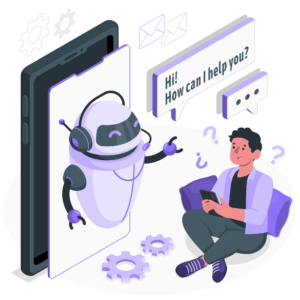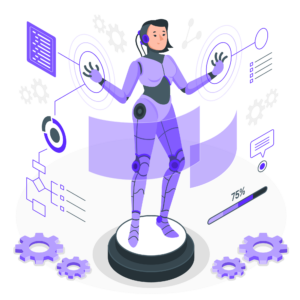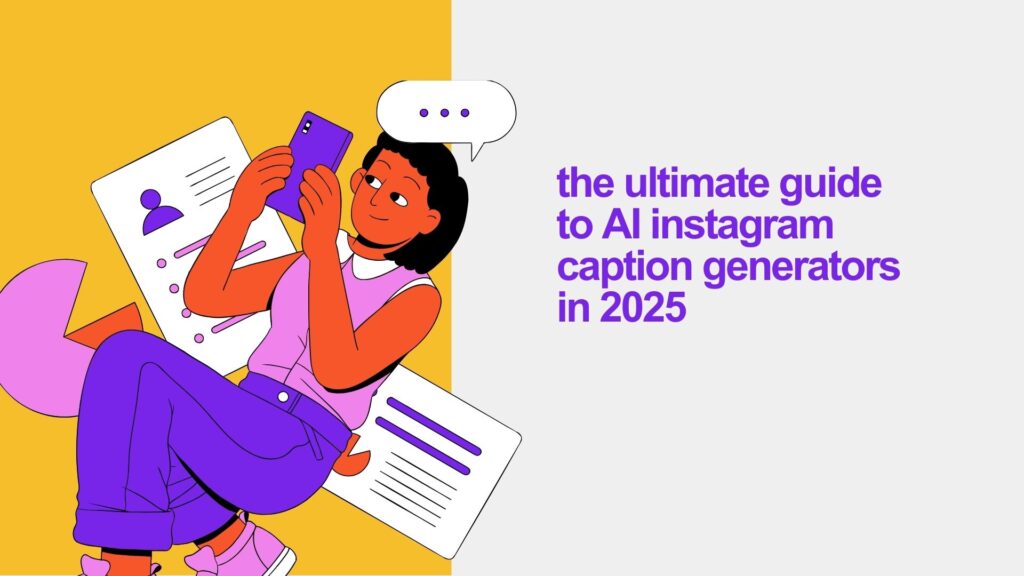
AI content creation is changing the game for marketers and writers. With powerful tools at your fingertips, you can now produce high-quality content faster and more efficiently than ever before. These AI assistants can help with everything from research and topic generation to writing and editing.
Table of Contents
AI content creation tools can boost your productivity by up to 10x while maintaining quality standards. By leveraging machine learning algorithms, these platforms analyze vast amounts of data to generate relevant, engaging content tailored to your needs. You can use AI to brainstorm ideas, outline articles, write drafts, and even optimize for SEO.
But AI isn’t meant to replace human writers. Instead, it works best as a collaboration tool to enhance your creative process. You still need to provide guidance, edit output, and add your unique voice and expertise. When used wisely, AI content creation allows you to scale your content efforts and focus more time on strategy and high-level tasks.
Key Takeaways
- AI tools can dramatically speed up content creation while maintaining quality
- Human input and editing remain essential for the best results
- AI content creation allows you to scale efforts and focus on high-value tasks
Understanding AI Content Creation

Online illustrations by Storyset
AI content creation uses computer algorithms to produce written, visual, and audio material. AI tools can help create blog posts, social media updates, videos, audios, music and more.
The Rise of AI in Content Production
AI for creating content tools are becoming more common. They can write faster than humans and work around the clock. Many businesses now use AI to make more content in less time.
These tools use data to learn writing styles and topics. They can quickly create first drafts, which lets human writers focus on editing and improving the content.
AI can also help with SEO by suggesting keywords and topics, analyzing which content performs well, and giving new ideas.
Differentiating AI and Human-Created Content
You can often spot AI-made content by its style. AI writing may sound more formal or lack personal touches. Human writers add unique insights and emotions that AI can’t match yet.
AI content might have factual errors or odd phrasing. It doesn’t truly understand context like humans do. This means AI content often needs human editing.
Human writers are still better at creative tasks and complex topics. They can make original ideas and connect with readers on a deeper level. The best content often comes from humans and AI working together.
AI Tools and Technologies

Online illustrations by Storyset
AI powers many content creation tools today. These technologies help with writing, images, videos, and understanding different languages.
Leading AI Writing Assistants
ChatGPT is a popular AI writing tool. It can help you draft articles, emails, and social media posts. Jasper is another AI assistant that creates marketing copy and blog content. Copy.ai focuses on generating ad copy and product descriptions.
These tools use large language models to produce human-like text. You can give them prompts or outlines from which to work. They save time on first drafts but need human editing.
AI Image and Video Generation Software
Midjourney and DALL-E create images from text descriptions. You can use them to make unique art for your content. They’re great for blog post headers, social media graphics, and ads.
For video, there are AI tools that can generate animated videos from scripts. Some can even create talking head videos with synthetic voices and faces.
These visual AI tools open up new creative options for content makers.
Natural Language Processing
Natural language processing (NLP) is how AI understands human language. It powers features like:
- Grammar checking
- Text summarization
- Keyword extraction
- Sentiment analysis
NLP helps AI writing tools understand the context and produce relevant content. It also enables chatbots and voice assistants to communicate with users.
As NLP improves, AI content tools will get better at following complex instructions and writing in specific styles.
Strategizing with AI Content

Data illustrations by Storyset
AI tools can enhance your content creation process and help you develop effective marketing strategies. These tools boost productivity while allowing you to focus on creative aspects.
Integrating AI into Your Content Strategy
Start by picking AI tools that fit your content needs. Look for options that can generate blog posts, social media updates, or product descriptions. Test different tools to find the best match for your writing style and goals.
Use AI to speed up your content creation process. It can help with research, outlines, and first drafts. This leaves you more time to add your personal touch and expertise.
AI can also help you analyze content performance. Use it to track metrics and get insights on what works best for your audience. This data can guide your future content decisions.
Developing a Content Marketing Strategy with AI
AI can help you plan your content calendar. It can suggest topics based on trends and your audience’s interests. This ensures your content stays relevant and timely.
Use AI to personalize content for different audience segments. It can help tailor messages to specific groups, improving engagement.
AI tools can assist with SEO optimization. They can suggest keywords and help structure your content for better search rankings.
Remember to keep your brand voice consistent. While AI can generate content quickly, make sure to review and edit it to match your unique style.
Content Creation with AI

Technology illustrations by Storyset
AI tools can help you make content faster and better. They can give you ideas, improve your writing, and automate parts of the process.
AI-Powered Content Ideation and Outlining
AI can spark new content ideas when you’re stuck. Just give it a topic, and it will suggest angles to explore. For example, if you’re writing about “healthy eating,” AI might propose subtopics like meal prep, superfoods, or diet myths.
AI can also help build content outlines. It can create a structure for your piece, complete with main points and subheadings. This saves time and ensures you cover key areas.
Some AI tools can even research topics for you. They can find relevant facts, stats, and quotes to support your content. This speeds up the research phase of content creation.
Enhancing Content Quality with AI
AI writing assistants can boost your content quality. They check for grammar and spelling errors, making your writing cleaner. Some tools suggest better word choices to make your content more engaging.
AI can help tailor your writing style to your target audience. It can adjust the tone and complexity of your content to match reader preferences.
These tools can also help with SEO. They can suggest keywords and ways to use them naturally in your content. This can improve your search rankings and reach more readers.
Automation of the Content Creation Process
AI can automate parts of content production. It can generate first drafts based on your input. You can then edit and refine these drafts to match your voice and style.
Some AI tools can create content in multiple formats. They can turn a blog post into a social media caption or a video script. This helps you repurpose content quickly.
AI can also help with content scheduling and distribution. It can suggest the best times to post on different platforms. Some tools can even automatically share your content across channels.
Optimizing Content for SEO

Work illustrations by Storyset
AI tools can help you boost your content’s search engine rankings. They make SEO tasks easier and more effective.
Keyword Research and Targeting with AI
AI-powered SEO tools help you find the best keywords for your content. They look at search volume, competition, and relevance. You can use these tools to pick primary and secondary keywords.
Make a list of your main topics. Put them into an AI keyword tool. It will give you related keywords and phrases. Pick ones that fit your content and have good search potential.
Use your chosen keywords in your titles, headings, and throughout your text. But don’t overdo it. Aim for natural language that reads well.
AI can also suggest questions people ask about your topic. Answer these in your content to boost your chances of appearing in featured snippets.
Achieving Consistency and Brand Voice
Your brand voice matters for SEO. It helps Google understand your site’s purpose and expertise. AI writing assistants can help keep your tone consistent across all content.
Set up your brand voice guidelines in the AI tool. Include things like:
- Preferred words and phrases
- Tone (formal, casual, etc.)
- Writing style (active voice, sentence length)
The AI will then suggest edits to match your brand voice. This helps create a unified feel across your site, which can improve user experience and SEO.
Remember to review AI suggestions. You know your brand best, so make final decisions on voice and style.
AI Tools for Content Optimization
Many AI tools can help optimize your content for search engines. Here are some key features to look for:
- On-page SEO checkers
- Readability scores
- Content structure suggestions
- Internal linking recommendations
- Meta description generators
These tools analyze your content and give tips to improve it. They might suggest adding more headings, shortening paragraphs, or using simpler words.
Some popular AI SEO tools include:
- Surfer SEO
- MarketMuse
- Clearscope
- Frase
Try a few different tools to see which works best for you. Each has its own strengths and features.
AI and Content Quality

Online illustrations by Storyset
AI tools can create content quickly, but quality is key. You need to know how to get the best results and polish AI-generated text.
Ensuring Quality in AI-Generated Content
To get good AI content, start with clear prompts. Tell the AI exactly what you want. Check that facts are right and ideas make sense. AI might make stuff up, so double-check important info.
Use AI to make first drafts, not final copies. Mix AI ideas with your own thoughts. This helps the content sound more real and match your style.
Make sure AI content fits your brand voice. You may need to tweak words or phrases. Keep an eye out for odd language or repeated ideas.
The Role of Editing and Proofreading
Always edit AI-written content. Look for grammar mistakes and weird wording. Fix any errors you find.
Add your own expert knowledge to make the content better. AI might miss important details in your field. You know your topic best, so fill in any gaps.
Read the content out loud. This helps you catch awkward phrases. Make sure it flows well and sounds natural.
Get another person to look at the content too. Fresh eyes can spot things you might miss. They can also tell you if the writing makes sense.
Personalization and Audience Targeting

Marketing illustrations by Storyset
AI-driven personalization helps create content that speaks directly to specific users. It uses data to tailor messages and experiences for different groups.
Tailoring AI Content for Different Audiences
AI tools can analyze user data to create personalized content. This includes things like emails, articles, and product descriptions. You can use AI to match content to people’s interests and behaviors.
For example, an AI system might look at a user’s past purchases. It could then suggest products they might like. Or it could show blog posts on topics they often read about.
AI can also adjust the tone and style of writing. It might use simpler language for some readers. For others, it could use more technical terms.
The Intersection of AI and Personal Experience
AI can make content feel more personal and relevant. It can use data on a user’s location, age, or job to customize what they see.
For instance, a news site could show local stories first. An e-learning platform might suggest courses based on your career goals.
AI can also learn from how you interact with content. It might notice which types of articles you spend more time reading. Then it can show you more of those in the future.
This personal touch can make your content more engaging. Users are more likely to stick around when they feel content speaks to them directly.
Challenges and Considerations in AI Content

People illustrations by Storyset
AI content creation brings up important issues around bias and privacy. You need to be aware of these challenges to use AI tools responsibly.
Addressing Bias in AI Content Generation
AI systems can pick up and amplify biases from their training data. This can lead to unfair or inaccurate content. You should check AI-generated text for bias regularly. Look for stereotypes or uneven representation of different groups.
Try using diverse datasets to train AI models. This helps create a more balanced output. You can also set rules for the AI to follow. These rules can promote fairness and inclusion.
Human review is key. Have people from different backgrounds look over AI content. They can spot biases the AI might miss.
Maintaining Privacy and Compliance
AI content tools often use large amounts of data. This can raise privacy concerns. You must protect user information when using AI for content creation.
Follow data protection laws like GDPR. Get clear consent before using personal data. Be open about how you use AI in your content process.
Make sure your AI tools don’t accidentally share private info. Use secure systems to handle sensitive data. Regularly check for any data leaks.
Stay up-to-date on AI regulations. Laws about AI use are changing fast. You need to adapt your practices to stay compliant.
The Future of AI in Digital Marketing

People illustrations by Storyset
AI is set to transform digital marketing in big ways. New tools and tech will change how marketers work and connect with customers.
Innovations in Generative AI
Generative AI is getting better at making content. Soon it will create videos, images, and text that look real. This will help you make more content faster.
AI writing tools will get smarter. They’ll learn your brand voice and make content that fits your style. You’ll be able to make blog posts, ads, and social media updates quickly.
AI will also make personalized content for each customer. It will use data to know what they like and make content just for them.
Advancing Marketing Strategy with AI Technology
AI will help you plan better marketing campaigns. It will look at lots of data to find trends and predict what will work best.
You’ll use AI to pick the right channels and times to share content. It will know when your customers are most likely to engage.
AI chatbots will get better at talking to customers. They’ll answer questions and help solve problems without humans.
AI will also help you track how well your marketing works. It will show you what’s working and what to change to get better results.
Frequently Asked Questions

Business illustrations by Storyset
AI content creation tools can help you produce various types of content quickly and efficiently. These tools range from free options to paid platforms with advanced features. Learning to use AI for content creation takes practice but can boost your productivity.
How can I start creating content with AI?
To start creating content with AI, pick a user-friendly tool like ChatGPT or Jasper. Sign up for an account and explore the features. Start with simple tasks like writing short social media posts or blog outlines. As you get comfortable, try more complex projects like full articles or email sequences.
What are the best AI tools for content creation?
Some top AI tools for content creation include platforms like ChatGPT and Copy.ai. Jasper is popular for longer-form content and marketing materials. Grammarly uses AI to improve your writing. Canva incorporates AI features for design tasks. Try a few different tools to see which ones fit your needs best.
Which AI tools are available for free to create content?
ChatGPT offers a free version with basic features. Rytr provides a free plan with limited usage. Canva’s free tier includes some AI-powered design tools. These free tools can help you get started with AI content creation without spending money.
How can AI be used to generate social media content?
AI can help create social media posts, captions, and hashtags. Use AI tools to brainstorm content ideas or generate multiple versions of a post. Some platforms can analyze top-performing content in your niche and suggest similar topics. AI can also help schedule posts and find the best times to share content on different platforms.
What resources are available for learning AI content creation?
Online courses on platforms like Coursera and Udemy cover AI content creation. YouTube has many tutorials on using specific AI writing tools. AI tool providers often offer their own training resources and documentation. Join online communities and forums to learn from other AI content creators and stay updated on new developments.
What are the steps involved in making AI-generated content?
First, choose a topic and gather key information. Input this data into your chosen AI tool along with any specific instructions. Review the AI-generated content and edit as needed. Fact-check important details and add your own insights. Polish the final piece to match your style and voice. Always proofread before publishing to ensure quality and accuracy.
